Terry L. Ettinger Horticulture Consulting Services
Meeting The Needs Of Today With A Vision For The Future
Question of the Week
Vertical Mulching for Stressed Trees
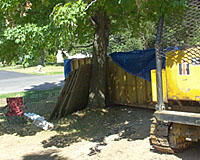 Q. The previous owners of our home
had a small excavation business and didn't hesitate to park their
equipment all over the front yard. Three years have passed since
we moved in and we’ve got the front lawn looking pretty good, thanks to the recommendations in your lawn care guide.
Q. The previous owners of our home
had a small excavation business and didn't hesitate to park their
equipment all over the front yard. Three years have passed since
we moved in and we’ve got the front lawn looking pretty good, thanks to the recommendations in your lawn care guide.
However, there’s a cluster of three medium-sized red maple trees - about to 20 feet apart - in the front lawn that aren’t
looking very healthy.
We’ve seen a tree “root-feeder” that attaches to a garden hose in various catalogs. Would it be a good idea to using one
of these devices to fertilize these trees?
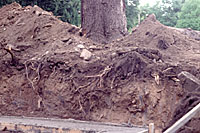 A. I’m not convinced “root-feeder” hose attachments are very useful.
A. I’m not convinced “root-feeder” hose attachments are very useful.
First, eighty to ninety percent of a tree’s root system is within a foot of the soil surface where there's sufficient oxygen for them to survive. Therefore, because of the random and relatively shallow distribution of tree roots, much of the fertilizer injected into the soil by these devices may end up below the roots.
Also, root-feeder attachments don’t reduce soil compaction. This is more often a cause of tree decline than is a lack of nutrients, because pore spaces through which oxygen can move through the soil are almost nonexistent in severely compacted soils.
Your home's former owner’s habit of parking vehicles on the lawn almost certainly damaged the root system of your trees.
The damage was caused both directly by physical crushing of microscopic “feeder” roots at the soil surface and indirectly by soil compaction that has reduce the ability of oxygen and water to penetrate into the soil.
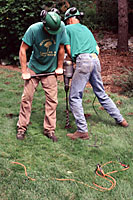 Instead of injecting fertilizer into the soil beneath the root system of your trees, I recommend that you hire a certified
arborist or nursery professional to perform a technique called “vertical mulching.”
Instead of injecting fertilizer into the soil beneath the root system of your trees, I recommend that you hire a certified
arborist or nursery professional to perform a technique called “vertical mulching.”
Vertical mulching involves the use of a heavy-duty electric or gas-powered drill, at right, to create a series of eighteen inch-deep holes with a two to three-inch diameter auger.
The holes, spaced about eighteen inches apart, below left, are drilled into the ground in
a twenty foot-wide ring beginning about ten feet inside the tree's "dripline" and extending about
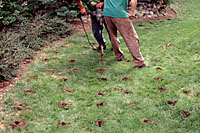 ten feet outside the dripline.
The holes are then filled with compost or calcined clay, below
right. The inclusion of a slow-release fertilizer with the above
materials should be based on soil test results.
ten feet outside the dripline.
The holes are then filled with compost or calcined clay, below
right. The inclusion of a slow-release fertilizer with the above
materials should be based on soil test results.
Similar to core aeration of lawns, the compost or calcined clay-filled holes allow oxygen and water to penetrate more readily into a
tree’s root zone. At the
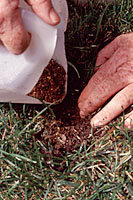 same time, potentially toxic carbon dioxide release by the root system can more easily escape into
the atmosphere. Within a few months, many of these holes will be filled with vigorous new feeder roots that thrive in the
moist, fertile, well-aerated compost!
same time, potentially toxic carbon dioxide release by the root system can more easily escape into
the atmosphere. Within a few months, many of these holes will be filled with vigorous new feeder roots that thrive in the
moist, fertile, well-aerated compost!
In addition to vertical mulching your stressed trees, I’d suggest enclosing all of three of them within a large bed (or "shared rooting space") covered with three to four inches of double-milled bark or wood mulch.
 The mulch will help retain soil moisture, cool the soil surface and return nutrients and organic matter as it
decomposes - just like litter on the floor of a forest! And, as an added benefit, when leaves drop from the trees each
autumn there’s no need to rake them. Just leave them right on top of the mulch where
The mulch will help retain soil moisture, cool the soil surface and return nutrients and organic matter as it
decomposes - just like litter on the floor of a forest! And, as an added benefit, when leaves drop from the trees each
autumn there’s no need to rake them. Just leave them right on top of the mulch where
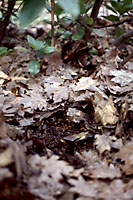 they’ll decompose over the winter
months - again, just like on the forest floor, at right.
they’ll decompose over the winter
months - again, just like on the forest floor, at right.